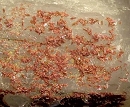
|
| Piemontite |
Chemical
Formula |
Ca2(Al,Mn3+,Fe3+)3(SiO4)(Si2O7)O(OH) |
Species |
Silicates |
Crystal
System |
Monoclinic |
Mohs
Scale |
6 |
Specific
Gravity |
3.45 |
Color |
Reddish-brown, reddish-black |
Streak |
Red |
Luster |
Vitreous |
Refractive
Index |
n = 1.725 - 1.756 n = 1.730 - 1.789 n = 1.750 - 1.832 |
Diaphaneity |
Translucent, Opaque |
Cleavage |
PerfectPerfect on Poor on |
Fracture |
Irregular/Uneven |
| Crystal Habit:Slender prismatic, blocky to massive |
| Geological Setting:Greenschist to amphibolite grade regional metamorphism, metasomatised manganese deposits, low temperature hydrothermal veins. |
Piemontite is a sorosilicate mineral in the monoclinic crystal system with the chemical formula Ca
2(Al,Mn
3+,Fe
3+)
3(SiO
4)(Si
2O
7)O(OH). It is a member of the epidote group.
Red to reddish-brown or red-black in colour, Piemontite has a red streak and a vitreous lustre.
The type locality is the Prabornaz Mine, in Saint-Marcel, Aosta Valley, Italy.
It occurs metamorphic rocks of the greenschist to amphibolite metamorphic facies and in low-temperature hydrothermal veins in altered volcanic rocks. It also occurs in metasomatized deposits of manganese ore. Associated minerals include: epidote, tremolite, glaucophane, orthoclase, quartz and calcite.


 YueGongAnBei 44051102000467
YueGongAnBei 44051102000467


 |
|